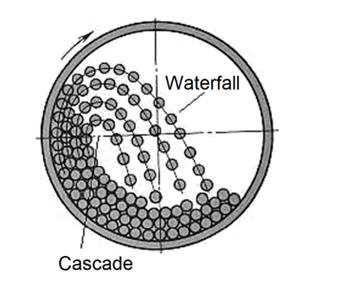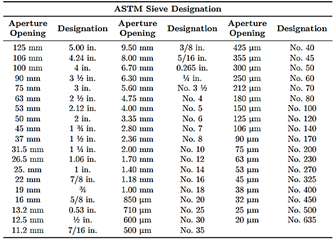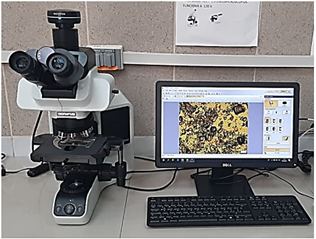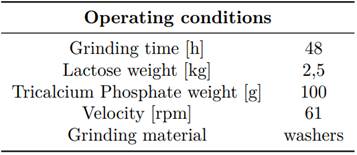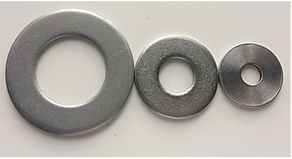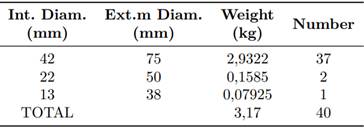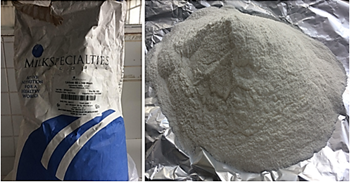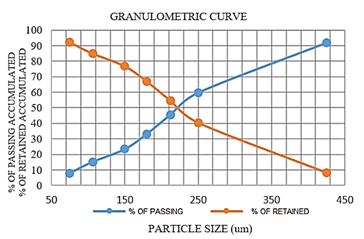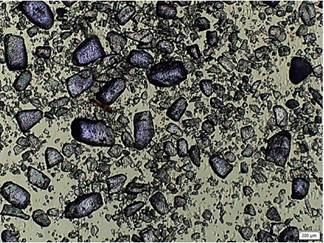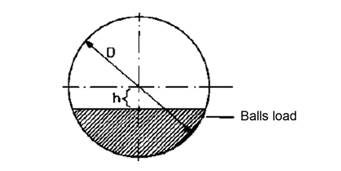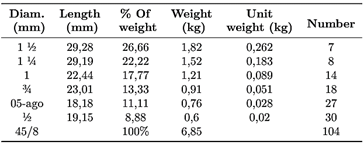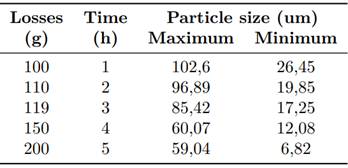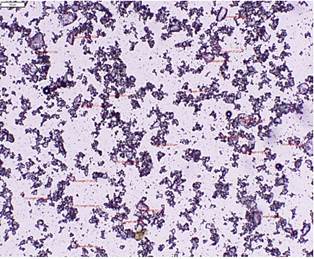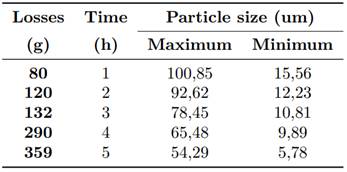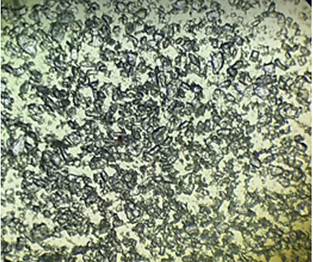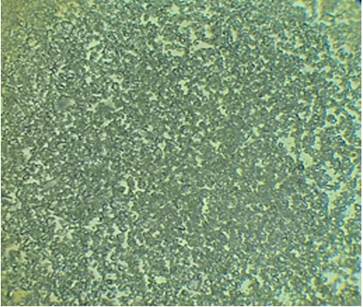|
Artículo Científico / Scientific Paper |
|
|
|
|
https://doi.org/10.17163/ings.n28.2022.07 |
|
|
|
pISSN: 1390-650X / eISSN: 1390-860X |
|
|
IMPROVEMENT OF THE LACTOSE GRINDING PROCESS FOR A
COMPANY MANUFACTURING DAIRY PRODUCTS |
||
|
MEJORA DEL PROCESO DE MOLIENDA DE LACTOSA PARA UNA EMPRESA FABRICANTE DE PRODUCTOS LÁCTEOS |
||
|
Darío j. Pinguil
Loja 1 |
|
Received: 08-09-2021,
Received after review: 30-11-2021, Accepted: 11-03-2022, Published:
01-07-2022 |
|
Abstract |
Resumen |
|
This research presents results obtained after
the implementation of an improvement in the lactose grinding process of a
company which manufactures dairy products. The current situation of the
process was determined identifying that a lactose particle size of 40.23 µm
is obtained in a grinding time of 48 continuous hours. After theoretical and
experimental research processes, it was obtained as the best option a fine
grinding with an average particle size of 22 µm in a grinding time of 5
continuous hours, using a drum mill with a volume of grinding elements of 25%
and an operating velocity of 61 rpm, and the Cylpebs
as specified in this research work; this generates savings in raw material
(lactose), energy consumption and operation time of the grinding process. |
Esta investigación presenta resultados obtenidos luego de haber implementado una mejora en el proceso de molienda de lactosa de una empresa fabricante de productos lácteos. Se determinó la situación actual del proceso, identificando que, en un tiempo de molido de 48 horas continuas, se obtiene un tamaño de partícula de lactosa de 40,23 µm. Posterior a los procesos de investigación teórica y experimental se estableció que con el uso de un molino de tambor con un volumen de elementos molientes del 25 %, una velocidad de operación de 61 rpm y el uso de cylpebs especificados en este trabajo, representan la mejor opción para obtener una molienda fina con un tamaño promedio de partículas de 22 µm en un tiempo de molido de 5 horas continuas, lo que genera principalmente un ahorro por materia prima (lactosa), consumo energético y tiempo de operación del proceso de molido. |
|
Keywords: Lactose, particle size, granulometric
analysis, cylpebs distribution |
Palabras clave: lactosa, tamaño de partícula, análisis granulométrico, distribución de cylpebs |
|
1,*Grupo de Investigación y Desarrollo en Simulación Optimización y toma de Decisiones GID- STD, Universidad Politécnica Salesiana, Ecuador. Corresponding author ✉: njara@ups.edu.ec.
Suggested citation: Pinguil Loja, D. J.; Lojano Pillco, V.R.; Jara Cobos, N. G. and Reinoso Avecillas, F. Z. “Improvement of the lactose grinding process for a company manufacturing dairy products,” Ingenius, Revista de Ciencia y Tecnología, N.◦ 28, pp. 71-79, 2022, doi: https://doi.org/10.17163/ings.n28.2022.07. |
|
1.
Introduction The quality policies and the global
market in general demand industries that they produce better quality
products, i.e., the market becomes more competitive, making the task more
difficult for many industries that want to remain in the market and,
especially, open new niches. This project
develops a proposal for improving the lactose grinding process, used as raw
material for producing condensed milk; in this sense, it has been sought to
purely achieve the reduction of the particle size, with the purpose of
obtaining a better consistency in the final product. At the initial
stage, it is determined the results of the current situation of the grinding
process parameters such as, operating time, grinding velocity, volume of raw
material (lactose) and particle size. The aim of this is to set the goals
necessary to fulfill the attainment of an average size of the particle of
25µm, feature required to manufacture condensed milk in the company.
Afterwards, an experimental analysis was carried out to determine the best
type of mill that enables to reduce the size of the particles and the
grinding time. The improved
particle size is determined by means of the macroscopic measuring process. The results obtained
prove that the size of the lactose particle as raw material significantly
improves the quality of the condensed milk texture, as one of the dairy
products that employs this raw material. The work of
analysis, proposals for improvement, experimental development and
measurements is found in a comprehensive manner in the final report of the
work by Lojano Pillco et
al. [1] 1.1. Parameters that influence the
grinding process There is a series of parameters
that influence the lactose grinding process [2], some of which are presented
below: - Critical velocity - Mill operating velocity - Relationship between the variable
elements of the mills - Size of the grinding elements -
Load volume - Distribution of the material to be
grinded -
Power -
Mill types |
Where: 1.1.1. The critical velocity Is the
one that occurs when the centrifugal force cancels the influence of gravity
on the balls. The following equation (1) determines this critical velocity
[3]. Vc= Critical velocity in rpm D= Mill diameter [m] 1.1.2. The mill operating velocity Should be smaller than the
critical velocity; the operating range of the ball mills or cylpebs is chosen between 65% and 80% of Vc [4]. Figure 1 shows the movement of the mill with its
cascade and waterfall effects, respectively.
Figure 1. Movement of the load in a
ball mill [5] Equation (2) is presented for
calculating the operating velocity [5].
Where: Vop = Operating velocity Vc = Critical velocity in rpm %Vc = Percentage of critical velocity 1.1.3.
The
relationship between the variable elements of the mills Considers mill variables such as
critical velocity, mill internal diameter and grinding bodies [2]. |
|
1.1.4.
Maximum size
of the grinding elements Should not present a unique
uniform size, but a distribution of the grinding elements is made from the
maximum diameter, but at lower sizes. The maximum size of the grinding
elements is obtained from the percentage distribution and the corresponding
dimensions of the components to obtain an effective grinding. 1.1.5.
The load of
the grinding bodies Makes reference to the fact that
the mills do not operate totally full. The volume occupied by the grinding
elements and the material to be grinded referred to the total volume of the
mill cylinder is known as the load of the grinding bodies, which is
calculated using equation (3) [2].
Where: B = Weight of the grinding bodies
[kg] b = constant (0,2 – 0,4) Vm = Volume of the material in dm3
δb =
density of the cylpebs 7,8 kg/dm3 D = nternal
diameter of the mill cylinder L = nternal
length of the mill The degree of
filling in the lactose grinding using cylpebs
typically comprises a load between 25 and 33% of the total volume, and is constituted
by the grinding bodies and the material to be grinded [3]. 1.1.6.
The
distribution of size of the grinding material, balls or cylpebs It may be determined through
various methods, of which two were used in this research: Method 1. According to the
diameter. Once
the initial load of the grinding material is known, the diameters of the
balls that are planned to be used are added. The sum corresponds to 100%.
Afterwards, the percentage corresponding to the value of each diameter is
determined. The result obtained corresponds to the percentage in weight of
the initial load, wich corresponds to each size of cylpebs. Method 2. According to the
diameter with Bond formula. Once the initial load of the grinding
material and their maximum size is known, the distribution percentage
corresponding to each ball size is determined using: Y= 100 (X/B)
3/2 ; this is taken to the graph to determine the
percentage in weight corresponding to each commercial size of cylpebs that should be fed. |
Regarding
the percentage distribution of the grinding means as a function of the
diameter, it is applied Bond formula given by equation (4) [6].
Where: y = % weight of grinding means with diameter
below x B = aximum ball
diameter [in] or [mm] x = diameter of the ball to be distributed [in]
or [mm] m = constant, its values are: (3,2 for rod mills or cylpebs) (3,84 for ball mills 1.2. Lactose The lactose appears as white
crystalline particles or powder. They are traditionally used in manufacturing
pills, and it is considered a sugar of great importance in the food
processing industries. It is an excellent excipient of tablets and pills,
among many other applications. The solubility of
lactose is ten times smaller than that of sucrose, if sugars added are
summed, the immediate problem will be to avoid the saturation of the
solution, since when the saturation limit is reached the excess of sugars
will precipitate as crystals forming lumps, physical defect that commonly
appears in commercial sweets [7]. In this sense, using a lactose with a
particle size around 30 µm results very convenient to improve the quality of
dairy products such as condensed milk. 1.3.
Methods for
measuring the particle size The methods of granulometric
analysis by sieving and microscopic visualization were used in this project. 1.3.1.
Granulometric analysis by sieving It is one of the most ancient techniques for
classifying powders through sieving. It is among the most commonly used and less
costly techniques for determining the particle size distribution in a wide
range of sizes, from little more than 100 mm to approximately 20 0 µm [8]
(Figure 2).
|
|
A
complete granulometric analysis consists in passing
a material, in general 100 grams representative of
the original sample, through a series of sieves, starting with a lower number
of meshes and ending with the one with the higher number. Table
1 presents the sieve designation according to what is established in the ASTM
E-11 standard. Table
1.
ASTM sieve designation and corresponding aperture openings [9]
1.3.2.
Microscopy
analysis It is a technique
that enables quickly visualizing the size and nominal shapes of the particles
in a sample, and obtain a representative micrography
of the region analyzed; in addition, it enables enlarging details of the
shape and surface of the particles [1] (Figure 3).
Figure
3. OLYMPUS BX43 Microscope 2.
Materials and
methods For the
research, it was carried out at first instance an evaluation of the current
situation of the lactose grinding process carried out at the company
manufacturer of dairy products, establishing the fundamental variables of the
process such as velocity, distribution of the grinding material and grinding
time. The samples were subject to sieves and microscopy to know the
current size of the |
particle and, based
on this information, a proposal was made for improving the lactose grinding
process with the optimal operating parameters. 2.1. Description of the current lactose
grinding equipment It is used a horizontal rotating mill with a
diameter of 20 cm and a length of 30 cm, capacity of 2 kg, power of 1 hp and a rotating velocity of 61.7 rpm; it employs
stainless steel washers as grinding elements (see Figure 4).
Figure 4.
Horizontal rotating mil 3.
Operating
parameters Table 2 presents the parameters used for the
lactose grinding process Table
2. Operating conditions
Regarding the washers used for the
grinding process, these are placed in a volume of approximately 12%, in a
number of 40 units, whose distribution is made according to their internal and
external diameter (see Table 3 and Figure 5).
Figure 5. Grinding material – Stainless steel washers |
|
Table 3. Distribution of sizes of
washers
As
it has been mentioned, the material to be grinded is lactose, which provides
sweetness to the milk. This product is commercialized in sacks of 50 kg (see
Figure 6), generally with an initial granulometry
of 150 µm, value determined by the manufacturer.
Figure 6. Lactose: sack and
sample With the purpose of
verifying the particle size set in the raw material, it was determined the
distribution of the particle size using the sieving method, considering a
sample of 100 g and a stirring time of 30 min [10]. Once such procedure has
been carried out [11], the previous results of the sieving process are seen
in Figure 7, where the curve of % of passing accumulated represents the
percentage of sample with its equivalent size, and the curve of % of retained
accumulated represents the percentage of material with a larger size (x).
Figure 7. Percentage of
passing accumulated and retained accumulated vs. particle size With what has been
determined and making average estimations of the particle sizes, based on the
sieve distribution and relating it to the mesh size in µm and the weight of
the retained fraction, values are presented to estimate the characteristic
average |
of the distribution of lactose
grain sizes as 241 µm (Table 4). This value differs from the certified size
of the lactose particle size, which is 150 µm, setting the need of choosing
another procedure for measuring the particle size. The microscopic
analysis enabled to quickly visualize the nominal size and shape of the
particles of a sample, and obtain a representative micrography
of the region analyzed; in addition, details of the shape and surface of the
particles are obtained through enlargement [1]. According to the
aforementioned procedure and an augmentation factor of 4x, it may be observed
that the lactose particles have heterogeneous and random shapes, with
different dimensions (Figure 8).
Figure 8. Lactose particles before
grinding 3.1. Particle size obtained-
current lactose grinding process Once the lactose has been subject to the
current grinding process, it is obtained the microphotograph of a sample, in
order to determine the average size and shape of the resulting particle (see
Figure 9).
Figure 9.
Lactose particles after 48 h of grinding After 30
measurements were performed, it was obtained a minimum particle size of 19.99
µm, a maximum size of 108.67 µm, which resulted in an average |
|
of 40.23 µm and a standard
deviation of 17.24 µm. In the sense, it has been possible to determine that
the current process reduces the size of the particle, but, due to the
heterogeneity of the particle sizes and to the larger number of grinding
hours (which causes that the lactose sticks on the grinding elements), this
raw material results inadequate to obtain condensed milk with the consistency
required by the company. 3.2. Improvement alternatives According to the research works, the following parameters are
considered for selecting the mill type: -
Grain size to be obtained -
Grinding time -
Grinding type -
Required power -
Cost After analyzing the
weighting of the parameters applied to the four types of mills that may be
employed for the lactose grinding process, namely planetary mill, attritor mill, drum mill and high energy mill, the drum
mill resulted the best option, achieving the highest weighting value (see
Table 4). Therefore, for the development of the present improvement project,
the horizontal rotating drum mill was used, to mainly determine the optimal
time, velocity and size distribution of the grinding material. Table 4. Weighting of
results- selection of the best alternative
3.3. Experimental grinding tests Three grinding parameters were taken into
account for the improvement process: size distribution of the grinding
material, grinding time and velocity; for this purpose, preliminary tests
were carried out with different types of grinding material: balls and cylpeb. Filling. The optimal filling of the mills
is determined according to equation (5) and Figure 10 [1].
|
Where: h = distance from the central axis of the drum D = drum internal diameter
Figure 10. Filling of grinding material [1] Critical velocity. After performing the
corresponding calculations, it is determined a critical velocity of 94.5 rpm;
thus, the operating velocity should be in a range from 65 to 80%, which
corresponds to values between 61.425 rpm and 75.6 rpm. Grinding material. Two types of grinding materials,
balls and cylpebs, were used for the tests, with
dimensional, weight and size distribution features as specified in Tables 5
and 6; for both cases it was kept constant a filling degree of 25% and a
velocity of 61.4 rpm. Table 5. Size
distribution of balls
Table 6. Size
distribution of cylpebs
4.
Results and
discussion Table 7 shows the results of the
five tests with different grinding times using balls as griding
elements; the particle sizes were measured using the microscopy technique, in
which three samples of each test performed were taken and, similarly, thirty
measurements for each sample were performed, giving as result the maximum and
minimum sizes of the lactose particles. In the different
tests performed, it was also observed that a larger grinding time implies
larger product losses, mainly due to the agglomeration of the |
|
lactose in the mill
walls and in the grinding bodies, as a result of the increment in the
operating temperature [1]. Table 7. Results obtained with balls
as grinding material
The test was
performed with 1050 grams of lactose and 100 grams of tricalcium
phosphate, with a minimum grinding time of one hour, because at that time the
reduction in the particle size of the product begins to be noted, and a
maximum grinding time established at five hours, because at that time a
larger agglomeration of the product in the mill walls and in the grinding
bodies begins to be noted. In this way, a good reduction in particle size was
obtained according to the microscopy images (see Figures 11 and 12).
Figure 11. Lactose particles grinded
for 1 h – Scale 100 µm
Figure 12. Lactose particles grinded
for 5 h – Scale 50 µm |
Table 8 presents the
results of the five tests performed at different grinding times, similarly
using 1050 grams of lactose and 100 grams of tricalcium
phosphate; the measurement of the particle sizes is carried out using the
microscopy technique, in which 30 measurements of each sample are carried
out. Table 8. Results obtained with cylpebs
as grinding material
Figures
13 and 14 display a difference in the sizes of the lactose particles, for
grinding times of one and five hours, where the sizes of the lactose particle
may be appreciated. One
of the factors that are established for improving the lactose grinding
process is the grinding material; in this case it is proposed to use cylpebs (stainless steel cylinders), because this shape
has a larger surface area to reduce the size of the lactose particle through
impact, enabling to obtain a larger number of fine particles in less time.
Figure 13. Lactose particles grinded for 1 h – Scale 100 µm
Figure 14. Lactose
particles grinded for 5 h – scale 100 µm |
|
Operating parameters
such as the time, velocity and size distribution of the cylpebs,
should be controlled for the grinding to be effective. These improved
parameters are presented in Table 9, which are compared with the results of
the current situation of the company. Table
9. Improved operating parameters
5.
Conclusions The variables identified that have influence on the lactose grinding process
are the size distribution of the grinding material, the grinding times and
the velocity, which impact the size of the lactose grain. Through the grinding tests
performed in the drum mill, it was possible to determine the adequate
operating parameters for the grinding process. Consequently, the cylpebs were selected as the most efficient grinding
material for the grinding process in fine products, with an effective
grinding time of 5 hours. The lactose load applied to the
grinding was optimized, because with less operating hours the raw material
does not stick on the internal walls of the drum nor on the grinding bodies,
significantly reducing the losses. With a particle size of 22 µm, it
was possible to qualitatively determine (through touch) the improvement of
the condensed milk texture, which represents for the company an improvement
in the product quality. References [1] V. R. Lojano Pillco, D. J. Pinguil Loja, and N. G. Jara Cobos, Propuesta de mejora
para el proceso de molienda de lactosa en empresas láctea. Universidad Politécnbica
Salesiana, Ecuador. [Online]. Available:
https://bit.ly/3a4IusB [2] A. O. Venegas Tomalá, Diseño y construcción de un molino de bolas para aplicaciones de pulvimetalurgia en los laboratorios de Ingeniería Mecánica de la Facultad de Ingeniería Civil y Mecánica de la Universidad Técnica de Ambato. Universidad Técnica de Ambato, Ecuador. [Online]. Available: https://bit.ly/3R0Ewlm |
[3] J. R. Alcántara Valladares, Diseño práctico de un molino de bolas. Instituto Politécnico Nacional, México, vol. 7, no. 2. [Online]. Available: https://bit.ly/3acXvIG [4] O. A. Gutiérrez Gutiérrez, Estudio para calibración de molinos. Universidad de Chile, vol. 158. [Online]. Available: https://bit.ly/3bH0Ujm [5] M. S. Altamirano Peralta and D. J. Sacoto Rivera, Evaluación experimental del proceso de molienda de crudo de UCEM planta industrial Guapán. Universidad del Azuay, Ecuador, vol. 1, no. 1. [Online]. Available: https://bit.ly/3xZFupi [6] G. A. Villablanca Robles, Estudio de prefactibilidad para la construcción y operación de una minicentral hidroeléctrica (MCH) en la subcuenca del río Palora, vol. 22. [Online]. Available: https://bit.ly/3NxFJxx [7] C. D. Char, HACCP, Microbiología predictiva y factores en combinación para mejorar la calidad de productos lácteos: dulce de leche: aplicación del concepto de factores en combinación y de la microbiología predictiva en el mejoramiento de la calidad del dulce de leche. Universidad de Buenos Aires, Argentina. [Online]. Available: https://bit.ly/3yy46qz [8] R.
C. Rowe, P. Sheskey, and M. Quinn, Handbook of
pharmaceutical excipients, Six Edition. Pharmaceutical Press. [Online].
Available: https://bit.ly/3xZGlGw [9] A. Jillavenkatesa, L.-S. H. Lum, and S. Dapkunas, “Nist recommended practice guide: Particle size characterization.” [Online]. Available: https://doi.org/10.6028/NBS.SP.960-1 [10] E. J. Montes Montes and R. Torres Gallo, “Determinación de los factores de forma de área (α) y volumen (β), de cristales de α-lactosa utilizando microscopia óptica,” vol. 13, no. 2, pp. 17–24. [Online]. Available: https://doi.org/10.21897/rta.v13i2.666 [11] E. A. Luna Méndez and F. T. Valencia Guaricela, Elaboración de guías prácticas de procesos metalúrgicos para el laboratorio de minas de la Universidad del Azuay. Universidad del Azuay, Ecuador. [Online]. Available: https://bit.ly/3Ai7fw8 |

